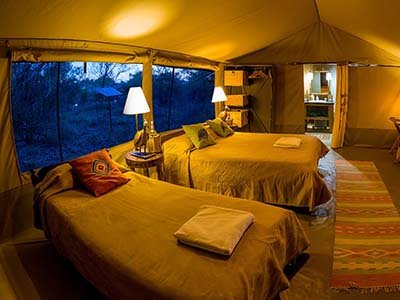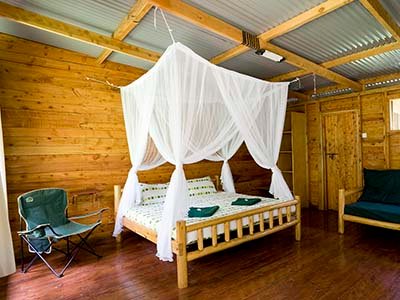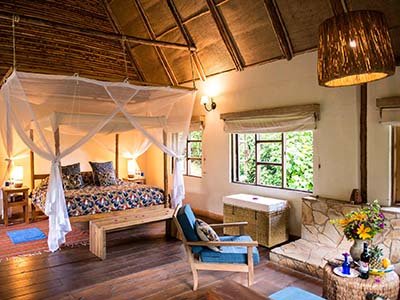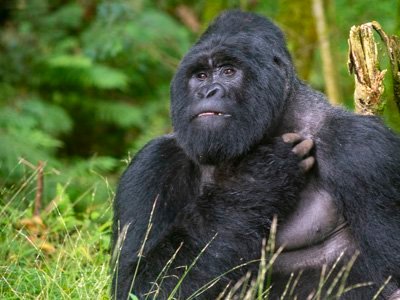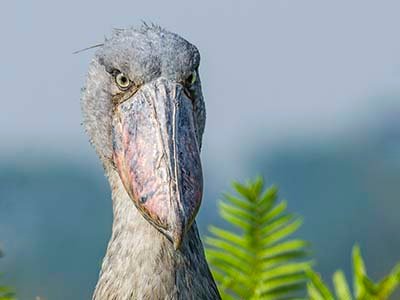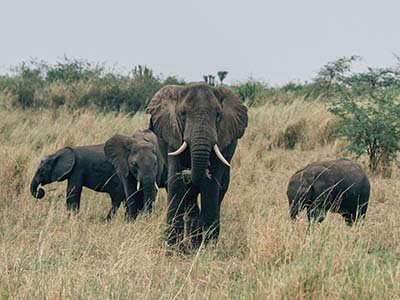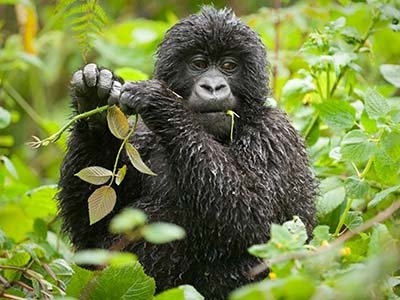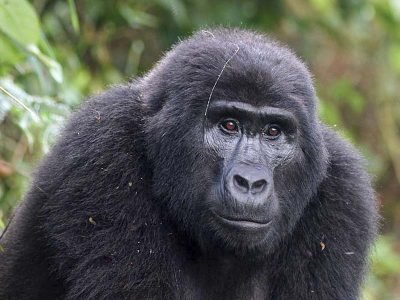The 321 km2 Bwindi Impenetrable National Park is located between 1,160 and 2,607 metres above sea level. It became a national park in 1991, and it was named a natural UNESCO World Heritage Site in 1994.
In April 1993, the Mubare gorilla troop in Buhoma became the first in Bwindi to be habituated for tourism. With fifteen groups habituated to tourism, four trailheads are available to follow them. These are found at Buhoma, Ruhija, Nkuringo, and Rushaga.
Mountain gorilla tracking in south-western Uganda Uganda’s isolated Bwindi Impenetrable Forest is Uganda’s top tourist destination and one of the most amazing wildlife experiences in the whole world. Less than 800 individuals make up the whole population of these remarkable apes, which live in the forests of Bwindi Impenetrable and the neighbouring Virunga mountains. The Impenetrable Forest is the world’s top location for mountain gorilla tracking, with fifteen groups habituated for tourists.
But Bwindi is much more than just gorilla tracking. While village treks provide a glimpse into the lives of the Pygmy Batwa and Bakiga people who live next to the forest and provide insights into their culture, forest paths lead to beautiful waterfalls and rift valley overlooks. Many Albertine Rift endemics may be found at Bwindi, one of the best places in Uganda for birding, especially in the soaring, windy Ruhija sector.
Wildlife in Bwindi Impenetrable National Park
The Bwindi Impenetrable Forest is one of Africa’s oldest and most diverse ecosystems, stretching for almost twenty-five thousand years over the creased and cracked edge of the Albertine Rift Valley. It is one of the few forests in Africa to have survived the dry conditions of the last ice age, some twelve thousand to eighteen thousand years ago. With an altitudinal range of 1147 metres, which can accommodate ecosystems from lowland forest at 1,160 metres to rare Afromontane vegetation over 2,600 metres, it has amassed an impressive amount of species in the process.
There are 310 butterfly species, 88 moth species, 200 trees, 51 reptile species, and 120 different kinds of mammals. Mammals comprise primates, including mountain gorillas, blue monkeys, L’Hoest’s monkeys, and chimpanzees, among others.
With 357 species, mostly forest birds, the birdlife is likewise very diverse. These include seven IUCN Red Data List species and 23 endemics (representing 90% of all endemics in the Albertine Rift), including the short-tailed warbler, Shelley’s crimson wing, African green broadbill, and blue-headed sunbird. There are fourteen species that are unique to Uganda, including the brown-necked parrot and the white-bellied robin chat.
People around Bwindi Impenetrable National Park
The Bakiga, a farming group that inhabits the Bwindi region, are in charge of creating the spectacular terraced slopes that go all the way to the southernmost boundary of the forest. Pygmy Batwa hunter-gatherers used to live in Bwindi forest, but now they live on the edge of the forest.
How to get to Bwindi Impenetrable National Park
About 460 kilometres (km) from Kampala, the major trailhead at Buhoma is accessible by road from many points. The Ishasha area of Queen Elizabeth National Park, where the main safari circuit enters from the north, offers an opportunity to look for the renowned tree-climbing lions. The park is located 62 kilometres from Ishasha and 160 kilometres from the centre of QENP at Mweya.
The shortest route from Kampala takes a paved road via Mbarara and Ntungamo to Rukungiri. After there, a laborious dirt road travels through the highlands through Kihihi and Butogota to Buhoma. The easiest approach to reach the Ruhija trailhead is to turn north off the paved highway 18 kilometres beyond Kabale town on the Kampala-Kisoro route.
Dirt roads heading west from Muko, halfway along the paved Kabale-Kisoro road, and north from Kisoro town may be used to access the southern Rushaga and Nkuringo trailheads. A 4×4 vehicle is advised for a trip to Bwindi.
Travelers may fly to Kisoro (for Nkuringo, Rushaga, and Ruhija) as well as Savanna and Ishasha airstrips from Entebbe International Airport or Kampala’s Kajjansi airport (for Buhoma). For the trip to the park, prior transportation arrangements are necessary.
Climate and Weather
The forest may be chilly, particularly in the morning and at night. The average yearly temperature ranges from 7 to 20 degrees Celsius, with June and July being the coldest months.
Wet weather gear is necessary in addition to warm clothes since Bwindi may get up to 2,390 mm of rain annually.
When To Visit
Any time of year is suitable for visiting the park.
Accommodations are available for travellers with a variety of spending preferences at the four trailheads. Hotels in Kabale and Lake Bunyonyi are also close to the Ruhija trailhead, while those travelling to Rushaga and Nkuringo might choose to stay in Kisoro or Lake Mutanda.
Attractions and Activities in Bwindi Impenetrable National Park
Mountain gorilla tracking
A wonderful hour spent with a family of mountain gorillas is the high point of a trip to Bwindi and the culmination of the arduous trek to the Impenetrable Forest by plane, vehicle, and steep forest route. The length of the trek will be determined by how far the gorillas have travelled since being seen nesting the previous evening.
As of December 2022, there are 23 habituated gorilla groups in Bwindi, and four trailheads allow for tracking. There are six of these groupings at Buhoma in the northwest region of Bwindi, four at Ruhija in the east, and the south has 13 groups, four at Nkuringo and nine at Rushaga.
For a total of 192 permits every day, eight permits are provided to track each of the 23 habituated groups. A reservation for a permit must be made in advance at the UWA Booking Office in Kampala. At 7:30 a.m., registration begins, and at 8 a.m., a briefing follows. 08.30 is when tracking begins.
Gorilla Trekking Rules and Regulations
A set of rules and regulations have been established to safeguard the gorillas and tourists, and they must be followed. It is your responsibility to get a copy of these guidelines from the park’s ticket office or the reservation office. Note that participants in the gorilla tracking programme must be at least 15 years old.
Birding in Bwindi Impenetrable National Park
All four of Bwindi’s trailheads are fantastic places to go birdwatching, especially if you’re hoping to see some rare species in the forest. The forest-edge Munyaga River and the Ivi River trails between Buhoma and Nkuringo are suggested. Both the Mubwindi Swamp and Ruhija’s Bamboo Trails, which lead to the 2607-meter-tall Rwamunyoni summit, are famous for harbouring Albertine Rift endemics, including the regional African green broadbill.
Nature walks in Bwindi Impenetrable National Park
Although going in search of gorillas is the major draw, other hikes provide a more leisurely opportunity to see one of Uganda’s most beautiful jungles.
Time slots are available for the following hikes between 9:00 and 14:00 daily.
A short stroll to see birds and primates along the forest edge is available on the Munyanga River Trail, which is in the valley below the Buhoma trailhead.
The Waterfall Trail winds through one of Uganda’s cleanest patches of rainforest, passing under tree ferns, epiphytic ferns, and orchids on its way to three sparkling, clear waterfalls.
The Albertine Rift Valley’s lowlands, as well as Lake Edward and the Rwenzori Mountains to the north, are seen from the Rushura Hill Trail’s broad vistas.
For stunning views of the Albertine Rift Valley, Bwindi Forest, and Virunga Mountains, hikers may ascend the Muzabajiro Loop Trail to the top of Rukubira Hill.
Through a lovely forest, the Ivi River Route travels along an ancient road until emerging close to Nkuringo on the southern side of the forest.
Community Walks in Bwindi Impenetrable National Park
Community tours through the communities on the outskirts of Nkuringo and Buhoma’s forests give visitors an insight into the lives of the nearby Bakiga and Pygmy Batwa populations.
The Batwa guides leading the Buniga Forest Hike at Nkuringo exhibit their customary knowledge of the forest.

